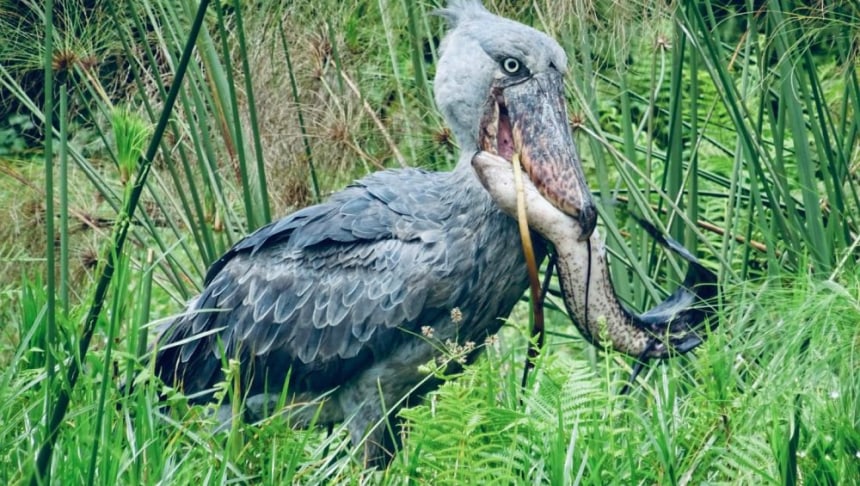
Mabamba Bay Wetland
Mabamba Wetland or Bay is compact natural wetland located on the edges of Lake Victoria, Northwestern Entebbe peninsula. Mabamba covers an area of 2424 ha and supports more than 300 bird species.
Mabamba Wetland is one of the 33 Important Bird Areas. It is a declared Ramsar sites since 2006. Mabamba swamp/Wetland has been worldly recognized by the Ramsar Convention as Wetland of international significance. Mabamba is home to threatened species of birds.
Mabamba Bay Wetland and Swamp, Location, Birds & More!
Location of Mabamba from Entebbe
Mabamba Bay or swamp is 40 km away from the heart Entebbe city. The wetland is set at the shores of Lake Victoria. Mabamba Bay/Wetland lies at an elevation of 1130 meters and surface area size of 64 sq. mi.
Bird species in Mabamba Wetland
A checklist of 300 species of birds exist in Mabamba wetland/swamp alone including the elusive shoebill storks, blue swallows, papyrus gonoleks, white-winged warblers, Pallid harriers, and yellow-throated greenbul.
Additional bird species to spot in Mabamba wetland include yellow-billed kite, yellow-backed weavers, yellow-billed kite, yellow wagtail, yellow-billed ducks, yellow-rumped tinkerbird, violet-backed sterling, tawny-flanked prinia, red-billed fire-finch, slender-billed gull, stripped kingfishers, ruppell’s long-tailed sterling, pygmy geese, sand martin, red-eyed dove, pink-backed pelicans, red-chested cuckoos, and purple heron.
Mabamba also holds birds such as the great white egret, little egret, mosque swallow, grassland pipit, Eurasian hobby, fork-tailed drongo, grey-crowned crane, Northern brown-throated, double toothed barbet, and common stonechat.
Expect to identify birds such as common waxbill, black-headed gonoleks, common squacco heron, common bulbul, African jacanas, cattle egret, African green pigeon, banded martin, African pied wagtail, Ashy flycatchers, African marsh harrier, black-crowned waxbill, black-winged stilt, brown snake-eagle, black-crowned night heron, and many others.
Shoebill watching and Mabamba wetland birding safaris
Shoebill stork birding excursions in Mabamba are best done using a canoe. During the birding tour to explore shoebills, expect to learn more about their unique facts.
Here are the 7 interesting facts about shoebill storks.
Several names: Shoebill storks take many names but essentially, they derive their name from the shape of their bills. The bill seemingly looks like a Dutch clog shoe.
Shoebills can kill: They feature enormous structure on their face measuring about 9 inches and 4 inches wide. The bill is very powerful tool shoebill storks use for scooping the big fish.
They can stare you down: Often spotted standing motionless like a statue and staring intently into the water for long period of time. They rarely blink, a feature that makes them closely watch their prey when it arrives.
Shoebill storks eat what others can’t or won’t: Lungfish is the most favorite food for the shoebills. They can also eat water snakes, small crocodiles, eels, and more.
They are huge in size: Shoebills measure about 5 feet by height. The weight of a grown shoebill is about 16 pounds. They can flap their wings 150 time per minute which is one of the slowest speed of any bird.
Elusive-The shoebill storks are described as elusive species.
Scientifically, shoebill storks are called Balaeniceps rex. They are among the huge African wading bird species in the Balaenicipitidae family.
Where else to find shoebill storks in Uganda?
Besides Mabamba, shoebills also exist in Queen Elizabeth National Park at the Ishasha sector, Ziwa Rhino Sanctuary, Murchison Falls National Park, Lake Mburo National Park, Nabajuzi Swamp in Masaka.
When to visit Mabamba wetland for birding tours
Mabamba wetland can be visited at any time of the year. However, the wet months of March to April and September to November offer favorable conditions for visitors to enjoy birding excursion.
Where to stay around Entebbe
Top places to consider for overnight stay before or after birding tours in Mabamba include Karibu Guesthouse, Protea Hotel Entebbe, Papyrus Guesthouse, Lake Victoria Serena Hotel, and others.
How to access Mabamba wetland
When on a birding tour, Mabamba can be reached using a canoe ride. Visitors can spend about 1 hour to drive to Nakiwogo Landing site in Entebbe where they can take a ferry to cross to Mabamba wetland. Guests can also take a boat on Lake Victoria and a speed boat can take you 45-50 minutes.
Things to pack for shoebill birding tour in Mabamba
Essentials to carry include a pair of binoculars, insect repellents, a camera, extra battery, waterproof rain jacket, a daypack, a safari hat, and comfortable safari clothes.


